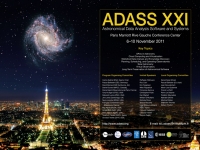Roc Cutri (IPAC/Caltech), WSDC Team (IPAC)
Abstract
The Wide-field Infrared Survey Explorer (WISE) is a NASA Medium Class Explorer mission that surveyed the entire sky in four mid-infrared bandpasses. WISE consisted of a cryogenically-cooled 40 cm telescope equipped with a camera that imaged the same 47'x47' field-of-view simultaneously onto four 1024x1024 pixel array detectors sensitive to 3.4, 4.6, 12 and 22 micron radiation. WISE was launched into a 525km sun-synchronous polar orbit in December 2009. Normal survey operations began in January 2010 and the first full sky coverage was completed in July 2010. WISE surveyed the sky in cryogenic mode until the end of September 2011, and then completed the second full sky coverage in warm, post-cryogenic mode in February 2011. The WISE Preliminary Data Release took place in April 2011 and included an Image Atlas and Source Catalog covering 57% of the sky. The WISE Final Data Release will be made in the Spring of 2012 and will contain the Image Atlas and Catalogs covering the full sky.
The Infrared Processing and Analysis Center (IPAC), California Institute of Technology is the WISE Science Data Center and is responsible for processing, archiving and distributing the WISE science data products. I will discuss the design, implementation and operation of the WISE Science Data System (WSDS) that performs these tasks. Developed at IPAC, the WSDS ingests raw science and engineering telemetry from the WISE ground system, converts them into calibrated image and extracted source lists in a highly automated software pipeline, assesses data and processing quality, and archives WISE data products on a rapid turn-around schedule. The WSDS design responds to the driving factors of WISE data rate, relentless data acquisition duty cycle, ambitious data release schedule, and stringent budgetary caps. Implementation takes advantages of best practices and lessons learned from IPAC's experience performing the same tasks for the two predecessor all-sky infrared surveys, IRAS and 2MASS, as well the development and operations of Science Centers and data processing systems
for other space astronomy missions such as the Spitzer Space
Telescope and GALEX.Slides in PDF format
Paper ID: I01
|

